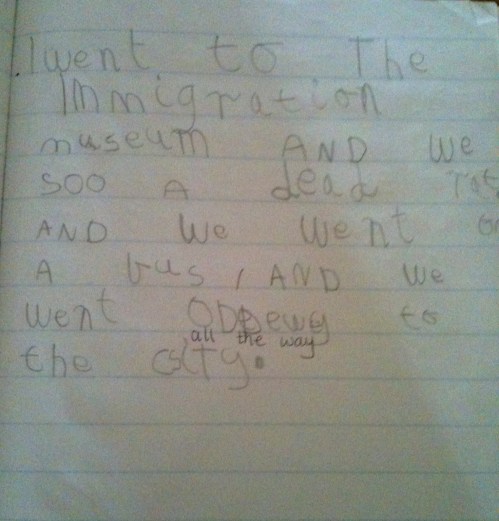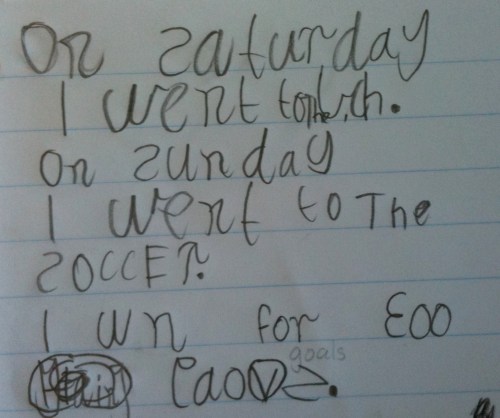Angela Stockman is a coach in New York and has left a comment on my post about Student Led Interactive Writing. I’ve included a copy of Angela’s comment below because it has a number of questions. I also thought a comment box just wouldn’t give this comment justice. You can visit Angela’s site by following this link and I strongly recommend that you do.
I find explaining what I do difficult because ‘I know what I know and do what I do’ naturally. It’s that ‘unconsciously skilled’ verses ‘consciously skilled’ biting back again. Once again I need to reflect in order to write and write in order to reflect… and I would have to say that is one of the reasons I blog. It makes me define my practice, thus moving me from ‘unconsciously skilled’ to ‘consciously skilled’. In order to share what I do, I need to operate in the later.
Angela’s Comment:
‘It is so inspiring to hear an experienced primary teacher speak to the fact that students CAN and DO teach their peers, reflect on their learning, and define their own needs. What does a typical day or block of writing instruction look like for you structurally Nina? I am fascinated by this!
I facilitate a writing community of teachers and young people. We are hopeful that over time, many of the kids in our program will evolve into great teachers of writing, and we work to identify those kids and support them by providing them with great teaching strategies and opportunities now. I’m wondering if your approach might help us!’
Background:
Four years ago I was teaching a Year 3 / 4 (8 – 10 year old students in Australia) and at the time we were preparing for our government testing. I was talking to my students and they asked me what a good piece of writing was in my opinion. What a great question and one they were entitled to ask. We had been looking at writing genres in-depth but somewhere along the way my teaching missed the mark.
For my students to improve their writing skills they needed to know what a good piece of writing ‘looks like’ when written, ‘sounds like’, and ‘feels like’ when read. To do this I used the deconstruction model introduced to me by Lane Clark. I proceeded to gather what I believed were good examples of writing for each genre. At the time I used material taken from CARS & STARS a reading comprehension program I was using. The children then worked in groups and used the ‘jigsaw’ thinking tool to record their findings. Sharing our findings as a class was powerful and meant we had to negotiate writing criteria for good pieces of writing. This was a great start, but just not enough.
I remember showing my students the Victorian Essential Learning Standards Moderation Guide. The document wasn’t suitable in its form due to its language, so I decided change parts of it for my students to use. This made the document ‘user friendly’ for the students. As a whole grade, we went through the document which included writing samples – this visual component was essential for the children. I noted at the time that the engagement level of my students skyrocketed because I think they felt that I was letting them in on ‘secret teacher’s business’.
Very bravely, they decided to look at their own writing and see where their writing measured up against the standards. To my surprise their personal and honest self assessment and conversations about their own writing was ‘bang on’. There are teachers who struggle with writing moderation, but these children did not. It also gave each student direction. I remember having a chat with each student, discussing their progress and given their new understanding, what they felt they needed to do to move their writing on.
Experience tells me that learning is positive for all children, no matter what their standard, if they can see their learning moving forward. It’s that ‘success builds success’ theory in action. Children feel empowered when they understand and have some control of their individual journey, making a commitment to self improvement/reflection and knowing what they need to do to improve. It’s no different for me; I like to know what is expected of me and how to move my teaching and learning forward.
I’ve always let children have a say about what our class should be like. We’re a team and all team members have a responsibility to each other and themselves. I have also allowed children to lead and question their learning, so it seemed natural for me to build on this… and the fact that I’m teaching 4-6 year olds didn’t alter my teaching philosophy. Hence, I try to make learning experiences student led when possible. I’ve been developing the PD Student Led Interactive Writing strategy for two years. This strategy is embedded in my teaching and I believe using this strategy enables children to develop a real understanding of the writing process. I also believe this strategy combined with the Early Years strategies will lead to long term gains, not short term. Please ‘track back’ through my blog as I have written many posts about this strategy.
So, what does a typical day or block of writing instruction look like structurally?
Writing everyday is crucial. I try to follow a program that becomes familiar to the children; however, nothing is set in concrete, so my program can be changed to respond to the children’s learning needs, our inquiry or their interest. Different genres are introduced to support our planned inquiry. As many of my students are beginning writers, teaching genres tends to be left until later in the year. My program is Language Experience and Play Based Experience based. I won’t explain these in this post as explaining these approaches needs a dedicated post. However, if you put Language Experience in my search box you can read other posts I have written and view a slide show for a presentation I gave. If I gave this presentation again, my slide show would change. I am constantly learning, improving and refining my practice.
THE WEEKLY BASICS OF MY WRITING PROGRAM:
Oral Language– Build it daily:
I move children to different areas of the room for each activity. Movement is important for young children. I find it helps children to focus. I use these activities throughout the week to build oral language. Children with poor oral language find the going tough. Oral is crucial and underpins all that I do!
Oral Language Activities: Start every day – 10 Minutes – I give my little strategies ‘made up’ names so that the children become familiar with the expected task.
The Chat Room: Speaking and Listening – News, Show & Explain – Question & Statements
Give me Another Word & Then Another: e.g. Go-start, begin etc… See how many words of similar meaning they can give for a word. Beginning of the year – Prep 1/2 – build to 10 words by the end of the year.
Talk About You Time: News
Big Pictures / Big Ideas: Discussion
Daily Big Book Fun Time: Concepts of Print
Retell it!
What do we know about sentences, words, letters & punctuation?
Alphabet Knowledge – phonics / blends etc.
Disco Writing: Bee Gees – Staying Alive (Words changed to ‘Stay on the Line’ and ‘yes’ their is the dance. Sensory Activities, Letter Formation
Shared Experiences Recap: school life – incursions/excursions etc.
Build me a Sentence: Sentence Board, Magnetic Letters / Words, Mini White Boards
Our Language Experience Little & Big Books made using Student Led Interactive Writing Text
Wonderings : Questions students would like answered is incorporated daily and used to direct focus content.
HERE ‘TIS’ – A ROUGH GUIDE!
Monday
10 Minute Writing Focus (teacher choice and/or a ‘Wondering’)
Modeled Writing Strategy (Whole Class) Revisit concepts, skills
Independent Journal Writing
Sharing and reflecting on our learning – 10 Minutes
Tuesday
10 Minute Writing Focus (teacher Choice and/or ‘A Wondering’ explained)
Using thinking tools and recording thoughts/discussion to assist our writing
Shared Writing Strategy – Responding to literature / Analyzing – understanding different types of writing
Sharing and reflecting on our learning – 10 Minutes
Wonderings: Children brainstorm things they’d like to know and learn about related to writing.
Wednesday
10 Minute Writing Focus (teacher Choice and/or ‘A Wondering’ explained – related to genre)
Using thinking tools and recording thoughts/discussion to assist our writing
Independent Writing – Narratives, Letters, Reports, Recounts, Cartoons, Opinion etc…
Sharing and reflecting on our learning – 10 Minutes
Thursday
10 Minute Writing Focus (teacher Choice and/or ‘A Wondering’ explained – related to genre)
PD Student Led Interactive Writing – related to a shared experience (This is when I often take a ‘needs based’ group not ability group for Teacher Led Interactive Writing)
Sharing our reflecting on our learning – 10 Minutes
Wonderings: Children brainstorm things they’d like to know and learn about related to writing.
Friday
10 Minute Writing Focus (teacher Choice and/or ‘A Wondering’ explained – related to genre)
We Love to Write Workshop – free choice
Sharing our reflecting on our learning – 10 Minutes
I try to take a small group each day which is teacher led and rove and support children when not taking a group. Teacher Led Interactive Writing and Guided Writing are strategies I favor when working with small groups.
We also write at other times of the day to support our inquiry and for pleasure. The key for developing great writers is to build oral language. It’s hard to write if you don’t have a strong vocabulary to draw on. I call my teaching approach to literacy ‘The Interwoven Approach’. I weave all areas of language e.g. phonics, sentence structure, letter formation / recognition into my daily program and focus on a particular need. I try to always link new knowledge to known concepts and understandings, so what is being taught is meaningful and in context.
There are numerous other things I do, but what I have described are the main strategies I consistently incorporate. As the year moves on, students are asked to lead / teach our writing focus and share time. Now if 4-6 year olds can confidently do this imagine what the capabilities of older students are.
To answer Angela’s second question- I believe that if a teacher just embedded Interactive Writing – PD Student Led & Teacher Led into their program, their children’s writing would FLY! Big statement, but I think I can ‘back it’.
Cheers Nina
P.S It’s hot in Melbourne – Its 1am and still in the 30’s. I tempted, no, going for a quick night swim – nice!
To Angela: Once again thank you for your comment and I hope this makes sense. What do I need to make clearer?

























































